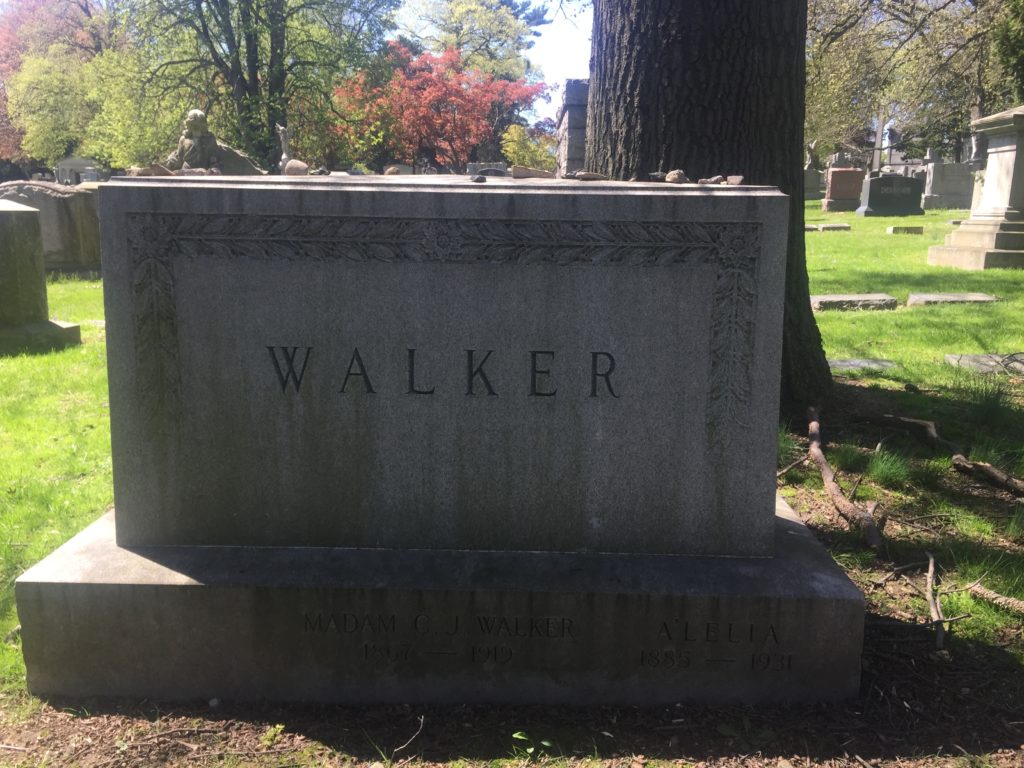Erik Visits an American Grave, Part 606
This is the grave of Madam C.J. Walker.

Born Sarah Breedlove in 1867 in Delta, Louisiana, she was the first member of her family born into freedom. She was an orphan by 1874, with her mother probably dying of cholera in 1873 and then her father of something else a year later. She moved to Vicksburg, Mississippi in 1877, where she lived with her older sister and that sister’s husband. She was put to work soon after as a domestic laborer. Like many black children before or after emancipation, she received very little education, just a little in the church and all of three months in a schoolhouse. She may well have been sexually abused by her brother-in-law and she married at the age of 14, at least in part to escape him. She was widowed at the age of 20, with one daughter to support. She remarried but divorced her second husband a few years later.
In 1888, Breedlove and her second husband moved to St. Louis, where she worked as a washerwoman. She was determined to give her daughter an education and saved all she could for that. Like many laundresses, Breedlove suffered skin problems. Hair loss was a major problem for her and other black women as well. This was especially true for people who worked with the soaps and lye of the laundries, but was a general problem too due to nutrition, soaps, hard work, and infrequent bathing. Three of her brothers lived in St. Louis as well. Some number of them worked as barbers. They had taught their sister a great deal about hair care. She started using that knowledge to sell the hair care products of Annie Malone, a pioneering black female entrepreneur. For the next few years, the women worked together. Breedlove moved to Denver in 1905 and started her own hair care business, while selling Malone’s products.
This partnership between the women soon floundered. Breedlove, now going by Madam C.J. Walker after she married her third husband and evidently decided to create some distinctive initials and a title borrowed from the French for her products, went into business with her own products. Malone accused Walker of stealing the formula, which may have been true, but both were using a combination of petroleum jelly and sulfur, which had been in use as a hair care product anyway and neither of them invented it. By this time, Walker was in Denver. She and her husband decided to go into business together. He handled the advertising; Walker sold the products door-to-door and trained other black women to sell them too. By this time, Walker’s daughter was grown. Within a few years, while Walker now traveled the country selling her products and building her markets, her daughter remained in Denver running the mail-order side of the operation.
In 1908, the family moved to Pittsburgh, much more of a black center of America than Denver. There, Walker started a beauty college and ran training sessions of economic independence for black women. In 1910, she started basing herself out of Indianapolis and in 1913 opened an office in Harlem. In all these places, Walker’s operation became a center of black female culture. By the time she was in Indianapolis, she had a whole complex, including a research laboratory to find new quality hair and beauty products.
The 1910s was the peak of Walker’s empire. By this time, she had developed an entire hair regime she hawked and employed around 8,000 women to sell the product around in the nation. She is often said to have become the first black female millionaire in American history, but this isn’t quite true as she never had that much money, though she was very wealthy for anyone of her time, not to mention someone of her race and gender. She flaunted it too. Mansions, a nice car with a driver. But she was always concerned with more than just her personal wealth. She really wanted to build economic independence for black women. She established the National Beauty Culturists and Benevolent Association of Madam C. J. Walker Agents in 1917. It’s first meeting was probably the first national meeting ever to discuss economic independence for black women. She began to give away large amounts of money, funding YMCA chapters in black communities and giving generously to educational foundations and institutions to school black children. In 1916, she moved to New York and hired the nation’s first certified black architect, Vertner Tandy, to build her a new house. That home, which cost $250,000 to build, became a central part of the black community. While in New York, she got to know other leading black figures such as W.E.B. DuBois and Mary McLeod Bethune. She joined the NAACP and helped organize protests against the race riots of the World War I era.
Alas, Walker had high blood pressure and it was not properly treated. She also suffered from kidney problems. She died in 1919, only 51 years old. The company remained quite profitable for a very long time after this, with her daughter running the operation, expanding it into the broader African diaspora in the 1920s, especially in the Caribbean.
Madam C.J. Walker is buried in Woodlawn Cemetery, Bronx, New York.
If you would like this series to profile other leading African-Americans of this period, you can donate to cover the required expenses here. Annie Malone is in Alsip, Illinois and Vertner Tandy is in Hartsdale, New York. Previous posts in this series are archived here.
